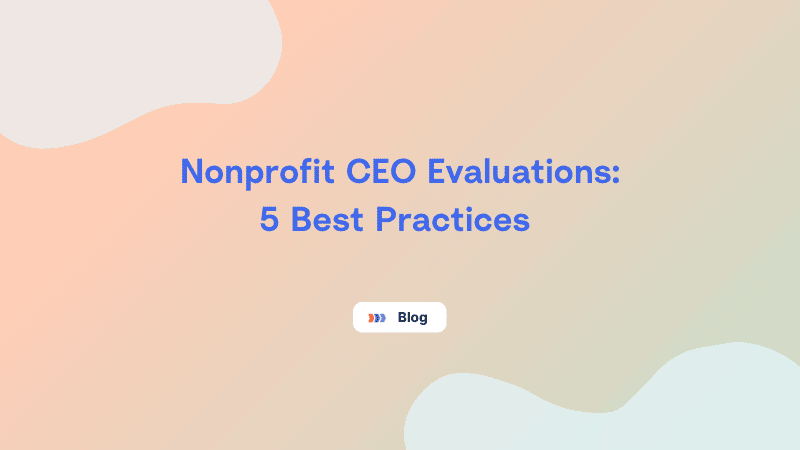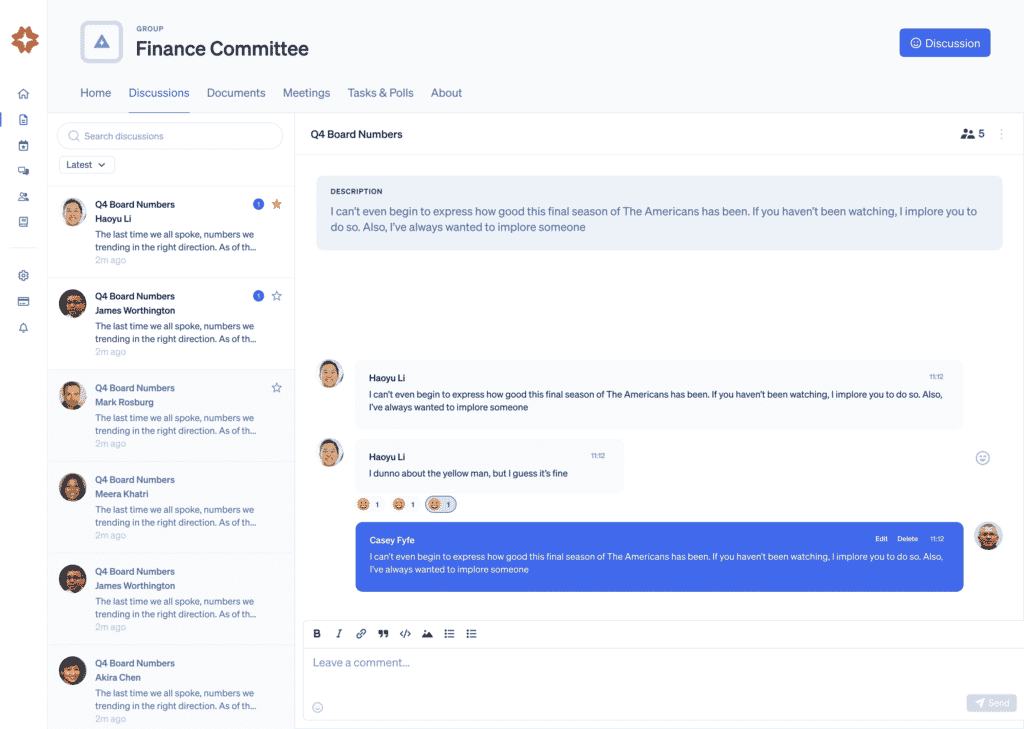There are many areas where nonprofit and for-profit operations diverge. However, making sure that leadership is equipped and motivated to meet the demands of leading an organization is crucial to both types of enterprises.
Just like at a business, a nonprofit CEO should have periodic evaluations. It is important to make sure the nonprofit CEO is making progress, but the board should also use this as an opportunity to find out how they can better support the executive director or Chief Executive Officer in their role.
In short, there is so much valuable information to be learned and shared from a nonprofit CEO assessment, when done well.
Here are the topics we cover here on nonprofit CEO evaluations. Feel free to skip to the section you need or read straight through:
- Why Do a Nonprofit CEO Assessment?
- The CEO Evaluation Process
- What to Include in the Evaluation
- Nonprofit CEO Evaluation Best Practices
- A Tool for Long-Term Success
- Conclusion
Why Do a Nonprofit CEO Assessment?
The reality is that everyone needs feedback and review to continue growing in their field. Often, the more responsibility you hold in an organization, the more public that evaluation process becomes.
This is the case with evaluations and performance assessments for nonprofit leaders. Many within the nonprofit system may undergo a highly private review process. Conversely, the CEO is typically engaged in an evaluation by the entire executive board.
When you have a group of any size considering professional performance, it’s important to have a predetermined set of parameters and shared language. The goal is to make the review process as objective, fair, and valuable as possible.
There are a number of specific reasons that we should do formal nonprofit executive director assessments. We will get into the reasons these evaluations are so important for legal reasons, executive performance, mission outcomes, and board member orientation in the following paragraphs.
The CEO Evaluation Process
Nonprofit CEO evaluations must follow a predetermined set of guidelines, which was included in the employee contract. Ideally, there is no disparity between expectations. These guidelines should outline how and when the performance evaluation will be completed, what criteria the performance will evaluate, and how the findings will be utilized for professional growth. This should all take into consideration the needs of the nonprofit organization as well as the individual.
Most corporate structures conduct nonprofit CEO evaluations annually. Sometimes there is more frequent evaluation for those who need additional support or who have not been in the field very long. It is also up to the board how the evaluation will take place.
This may include:
A self-evaluation process
Most CEOs are ambitious, energized self-starters. Chances are that he or she will have a list of expectations for themselves that is more extensive than anything an external party could draw up. The self-evaluation process allows the executive director time to review the goals he or she set the previous year and think about how more progress could be made.
Reflection reports on personal performance and growth plans
After or in addition to a self-evaluation process, it may be beneficial for a CEO to bounce his or her insights to the board. What areas surprised the CEO? Where could he or she have used more support? What seems the most challenging of the growth plans, and how can the board help the executive succeed?
Reports collected from staff, customers, clients, funders, or other partners
You may have heard of this called a “360-degree evaluation.” The efficacy of this method on its own is under some scrutiny, but the perspective of those who work with the CEO can certainly be beneficial to some degree. The crucial point of these nonprofit CEO assessments is to make sure they are productive, and not just an airing of unspoken grievances.
Intermittent observations conducted by the board members
Regular doses of smaller feedback can also be helpful to nonprofit leadership. This could be similar to the “plus/delta” method we talked about in board assessments. For example, board members could weigh in on what is working and what could improve in their observation. It’s important that this doesn’t become personal or nitpicky, but always has the growth and success of the whole organization in focus.
What to Include in the Evaluation
Once the parameters of the nonprofit CEO evaluation are set, it is important to predetermine what factors are going to be assessed. These attributes should remain consistent across the evaluations of all company personnel. (RELATED: How and When to Hire Nonprofit Consultants)
Quantitative Evaluation Metrics
As we all know, quantitative metrics are those benchmarks that can be measured numerically. When assessing qualitative evaluation metrics, the completion of them should be answerable with a yes or no. These considerations are especially helpful when deciding on bonuses and raises for the executive.
- Fundraising Goal Completion: Did we meet our development goals set for the year? Did we meet our goals of donor retention, average donation amount, and specific campaign goals? While this is a yes or no question, of course, it is important to remember that there are often factors outside anyone’s control.
- Increase in donors, gift size, constituents served, or projects completed: Are trend lines moving in the right direction? Are we building a good story to tell the community and possible funders? If not, why not, and what can the board do to help turn the tide?
- Growth of organization metrics: Executive directors will most likely have a goal of increasing the scope or depth of services provided. Whatever the desired measurement of the mission is, a periodic evaluation of progress needs to be recorded.
Qualitative Evaluation Metrics
Unlike the numerical quantitative metrics that can be a simple yes or no answer, qualitative factors are more subtle. These types of nonprofit CEO assessment areas may require a scale of measurement, verbal feedback, and the input of several different parties.
- Leadership skills: Is the CEO able to inspire the staff and volunteers to do their best work? What is turnover like under this executive, and what do people say at their exit interviews? Where does the CEO want to build more leadership skills? This is an especially important area that affects almost everything else the executive director does.
- Relationship-building skills: One major responsibility of a CEO is to foster beneficial relationships with a number of stakeholders. Depending on the type of organization, it may be important to build rapport with other complementary nonprofits or community organizations. Additionally, the executive director should work to build trust with board members and key staff members.
- Problem-solving and decision-making skills: Does the CEO meet standards of timeliness and professionalism? Can he or she demonstrate an ability to develop and follow an action plan? These considerations not only affect the effectiveness and growth of operations, but they also affect how your nonprofit is represented to the public. If your CEO makes questionable decisions in the public spotlight, it can adversely affect your organization for years to come.
Nonprofit CEO Evaluation Best Practices
The CEO of a nonprofit organization is responsible for so many different factors of day-to-day management, that it can be overwhelming to consider what aspects of the individual’s performance should be in the assessment. This is something that the board needs to decide on prior to the beginning of the observation cycle. Here are a few tips for how to do nonprofit CEO evaluations well.
Keep things fair, objective, and open.
As with any evaluation, clear expectations and agreed-upon measurements at the beginning of the term are crucial. By making goals clear, it is much easier to assess results in a fair and objective manner. There should be no surprises to anyone during the review!
Keep written records of evaluations from each year
Recording the nonprofit CEO evaluation is important for several reasons. Not only does it make it easy to see trends over time, but keeping written records also protects the nonprofit. If there are any public discrepancies about compensation amounts or termination, the record of nonprofit CEO assessments can help set the record straight.
Set SMART goals at the end of each year
SMART goals are: specific, measurable, achievable, realistic, and timely. By establishing these goals at the end of each year, the board and CEO take this opportunity to look at the past year’s numbers before setting goals for the coming year.
Use external salary benchmarks for your executive team
Again, this is an important measure for your nonprofit’s protection but also makes sure the CEO is treated fairly. By using external salary averages, your board doesn’t have to worry about justifying a wildly out-of-line salary (high or low). This practice can also guide discussions on bonuses and raises.
Include representatives from all levels.
If you decide to do a 360-degree evaluation, this is a good rule. A Bridgespan article on the 360-degree CEO review process at Citi Performing Arts Center vice-chair Jeff McCormick said,
“A board’s responsibility is to the overall enterprise, not just the leader. It is important to think about what you are trying to learn, framing the right questions, and strategically gathering input from a variety of sources. Ultimately, the results should help identify where the CEO should focus and where he or she actually is focusing.”
Evaluations: A Tool for Long-Term Success
The goal of a performance assessment is not to trap the employee into being “found out” for any present poor habits. Instead, it should address current skills and identify areas for growth. Obviously, we want the individual and the company to benefit as a result. Consistent and regular assessment of all members of the nonprofit team is the only way to ensure that the organization is managed as efficiently as possible.
Using performance evaluations as a means to continue conversations about company goals and growth is a great way to develop action plans and ensure that your nonprofit is working in the best interest of those you hope to serve.
Conclusion
Clearly, there are many reasons that a formal and recorded nonprofit CEO assessment is a crucial part of your nonprofit leadership operations. Hopefully by following these guidelines, your nonprofit can set your team up for success in the future, no matter who is leading!




